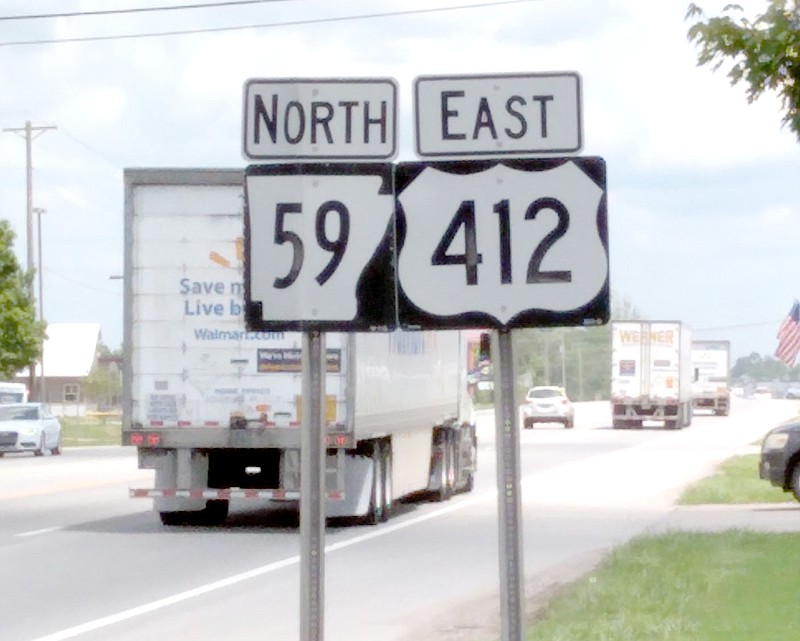U.S. Highway 412 may soon be designated as a future interstate connecting Tulsa, Okla., and the I-49 corridor Northwest Arkansas cities of Bentonville, Fayetteville, Rogers and Springdale.
While the future interstate may benefit Arkansas and Oklahoma, the possible interstate may impact Siloam Springs by detouring around the city instead of going through it.
Background
The Indian Nations Council of Governments (INCOG), a voluntary association of local and tribal governments in the Tulsa Metro area, passed Resolution 307 on May 11 urging the U.S. Congress to designate U.S. Highway 412 from I-35 to I-49 in Springdale as a future interstate, according to a copy of the resolution.
On Friday, May 21, U.S. Senators Jim Inhofe (R-Okla), John Boozman (R-Rogers), and Tom Cotton (R-Little Rock) introduced a bill to designate 189 miles of U.S. 412 as a future interstate highway, according to an article in the Northwest Arkansas Democrat Gazette on May 22.
The proposed interstate would improve supply chain connectivity for major retail and industrial employers in the region including Walmart in Northwest Arkansas and several energy and aerospace companies in Northeast Oklahoma, the article states. Boozman and Cotton released the following joint statement on Monday:
"An official interstate highway designation is a key component developers look for when deciding where to invest. We can continue encouraging future opportunities for economic growth by bringing highway 412 up to interstate standards. The introduction of our bill is the first step in this process. We look forward to working with our colleagues, communities along Highway 412 and the Arkansas Department of Transportation to make this a reality in the coming years."
Possible bypass
Speculations have risen that Siloam Springs will be bypassed by the future interstate. During the city board meeting on May 18, City Administrator Phillip Patterson said he found a study by the Arkansas Department of Transportation (ArDOT) from 2004, which looked at bypassing Siloam Springs and West Siloam Springs.
The executive summary of the study looked at three different corridors and recommended the preferred option for the bypass would take the highway north and north east of Siloam Springs and would best serve existing and planned industrial development, the summary states.
Tim Conklin, the assistant director for the Northwest Arkansas Regional Planning Commission (NWARPC) and Northwest Arkansas Regional Transportation Study (NARTS) director said in a phone interview on Monday the highway would have to be studied by ArDOT and the Oklahoma Department of Transportation (ODOT) before any decisions could be made about a bypass.
Not an overnight proposition
Leslie Price, a faculty researcher for Indiana University, who is working on her doctorate thesis Rebranding the Rural, which talks about rural economies and also discusses how I-69 affected rural Greene County, Ind., said interstates are not an overnight proposition.
"The process is so lengthy from the point of inception to getting it built because there is so much bureaucracy. It will take time," Price said.
She said I-69 was designated in the 1990s but ground was not broken until 2008. Price also said in the late 1980s and early 1990s there was a high priority list of corridors the government agreed to fund, many of which have not yet received funding.
Even states that are retrofitting roads to upgrade them to interstate funding have struggled to secure funding and palatial support to needed to complete the project, Price said.
The process involves mandatory public meetings, as well as an environmental impact study, approval from the Federal Highway Administration and money secured to build the interstate, Price said.
"Long story short -- it's a long way from wanting an interstate to getting one," Price said.
Patterson echoed similar comments during the city board meeting saying he does not think the bypass would occur in his lifetime.
What the public can do
Price said the best method for people who are either for or against the interstate need to contact their local and state representatives. State representatives hold the power of the purse, Price said.
"Even if (the proposed interstates) goes through and they get listed on the priority list and the government agrees to fund them, the state still has to come up with the money," Price said.
The federal government will match the state government at a 90/10 ratio, according to the Federal Highway Administration's frequently asked questions.
When asked how the interstate would affect Siloam Springs, Price said it was hard to say. Interstates are important pieces to future economic growth but not the only piece, Price said.
She has seen some towns that had interstates come through which did not bring the growth expected and other towns without interstates that had tremendous growth, Price said.

